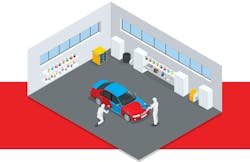For 30 days, he dedicated time and effort to it. On each successive job, he concentrated on his efficiency, his technique, his use of a primer surfacer when refinishing vehicles, all in an effort to improve the tool’s profitability.
You can’t necessarily expect that level of commitment from every painter—but, actually, it’s pretty standard for Jeramy Myers’ painters and estimators, who are all committed to improving paint and material profitability at Flawless Auto Body. The above example is case in point, as the painter presented his evaluations to the Flawless team, which led to the entire department more efficiently utilizing its surfacers.
“You’d be amazed at the power of presenting this information to your team and coming up with solutions to these problems,” Myers says.
This is just one example of many that showcases the culture both Myers and Jimmy Lefler, CEO of the four-location, Indiana-based Lefler Collision & Glass, have crafted at their shops. Achieving profitability in the paint department is a team effort, and each and every employee plays a part in the process.
From the paint department to the estimators, both Lefler and Myers—owner of the $4 million Flawless Auto Body in Great Falls, Mont., and a member of Mike Anderson’s Axalta Business Council 1—have completely revamped their approaches to managing paint and materials (P&M) sales and costs. In fact, they each have had the most notable P&M turnarounds within their lean materials management company group, J. Hunter & Associates, managed by industry consultant Jim Compton.
Here, the shop owners and Compton detail the KPIs and teamwork that ensure maximum paint department profitability.
Track the Right KPIs.
It’s a familiar phrase you’ve undoubtedly heard ad nauseum over the years. But Myers feels the need to repeat it: “You can’t manage what you don’t measure.”
That’s why identifying the key KPIs driving profitability in the paint department is step No. 1 for both Myers and Lefler.
Here are the six most indispensable statistics for both shops:
P&M Gross Profit Margin
“That’s the baseline,” Lefler says of gross profit margin. On a broader scale, this number will paint a picture of your department’s profitability. Both owners aim to remain above the industry standard, which they put between 25 and 30 percent.
“That number will tell me how we’re doing overall,” Myers says. “Then I can get into more specific KPIs.”
P&M Costs
At its core, this number reveals where you’re spending the most money. Lefler says that, oftentimes, the wastefulness of spending can escape operators and their paint team. By breaking down where you’re spending the most money, you can determine whether those investments are leading to or inhibiting profitability.
Paint Labor Hours Per $1,000 of RO
Compton says paint labor hours per $1,000 of an RO provides a level playing field for all shops and estimators, regardless of the size of the repair order.
“It is a good goal ... and a fast calculation for anyone to do on every RO,” he says. “We should look at averages, assume some ROs will be better and some will be less. This makes this an actionable KPI.”
Ounces of Color Per Refinish Hour
Assuming a reasonable number of refinish hours are being billed (tracked through the KPI above), a shop is not going to need less paint, Compton says, just because of what was or was not written on an RO. Like paint labor hours, he says this is an easily measurable KPI for the paint department to track and use as a goal.
Average RO Refinish Dollars
As someone who fueled all his original efforts into improving P&M costs, Myers can attest: Surprisingly, it’s easy to forget about sales. And there are often-overlooked KPIs that prove the power of your sales staff.
Average repair order is a straightforward KPI tracked by most shop owners, but Lefler says operators often forget to break it down to refinish dollars as well. This KPI allows him to measure each of his shops against one another on a wider spectrum.
“If one shop is at $2,500 per RO, but 75 percent of the teams are above $3,500, we’re not properly billing for what we're doing,” he says.
Refinish Hours/Sales Per R.O.
This calculation reveals if enough hours are being billed on estimates, Myers says. On top of that, low sales numbers could be an indication that estimators are accepting caps and thresholds on refinishing.
“Without doing a P&M invoice, you have no idea what this number is,” he says. “Let’s say you want to charge $20 an hour. Then you run a report and you're at $18 an hour. You know right away your estimate staff is accepting a P&M cap.”
Utilize Vendors and 20 Groups
—
Even though Jimmy Lefler’s team has brainstormed numerous process improvements for P&M profitability, he maintains that a healthy portion of his turnaround stemmed from outside feedback from shops and vendors.
“Get outside the box you're in and meet with non-competing operators,” he says. ”Everyone has something to contribute. Two-thirds of my best practices were things other people thought of.”
He also invites paint vendors to come in and evaluate his shop processes. They can usually spot when a material is being overused, determine strategies for maximizing efficiency, and produce ideas for improving volume long term.
Discuss Profits with Your Team.
Once you’ve identified the key KPIs, then it’s time to discuss them directly with your team. In Lefler’s experience, creating this conversation gets P&M profitability over the hill.
“We purchased a store ... and their P&M gross profit was nothing,” he says. “After nine months, they had improved it six times over. Everybody was sharing ideas and wanted to know how other groups were improving.”
Lefler hosts quarterly meetings that gather his four paint departments together. They discuss a number of P&M KPIs and offer tips to one another about processes and equipment that have improved efficiency, costs and sales.
Myers hosts similar meetings, and his estimators and painters often come away with game plans for improving numbers. By meeting about refinish hours per RO, his estimators agreed to attend sales training that completely turned the stat around.
Lefler suggests discussing KPIs in a visual manner whenever possible. For example, after a meeting where clear usage was discussed, he took several buckets and, with a Sharpie, marked them up with a vertical scale that went up to $2,000. That way, his teams could attach a dollar amount to their P&M usage and know if they were mixing too much clear. That motivation to improve P&M sales and costs has carried into every aspect of the paint process.
“They now count the number of hours they're going to paint in the booth to make sure there's 12 hours of refinish time that goes into each cycle,” he says. “They’ll set up a station in front of the booth and stage pieces of the next car going in. If there’s room for three more bumper covers in the booth, they’ll do that.”

